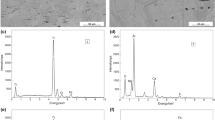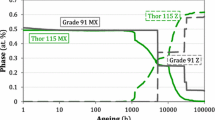Abstract
During the continuous casting of 430 ferritic stainless steel, the broadening phenomenon and bulging deformation are considered a high-temperature creep. This study investigates 430 ferritic stainless steel by conducting high-temperature uniaxial creep experiments under the temperatures of 0.4-0.5 Tm and stresses of 32.5-85 MPa. After creep deformation, the microstructure is analyzed by scanning electron microscopy, energy-dispersive spectroscopy, electron backscatter diffraction, and transmission electron microscopy. The creep curves show the “Normal type.” The creep stress exponent is 3.6-6.7. The creep activation energy is 476.533 kJ/mol. The dislocations climbed over the (Fe, Cr)23C6 are observed. The creep mechanism is dislocations climbing, and the precipitation strengthening contributes to the creep deformation. The recovery and recrystallization are confirmed during the creep deformation. Temperature, not stress, is the main factor in recovery and recrystallization. Numerous voids are observed around the precipitates. There are many dimples on the fracture surface. The creep fracture mechanism belongs to the Transgranular ductile fracture.












Similar content being viewed by others
References
L. Meng, H. Lu, W. Li, H. Guo, J. Tian, and W. Liang, High Strength and Plasticity of AISI 430 Ferritic Stainless Steel Achieved by a Recrystallization Annealing Before Quenching and Partitioning Process, Mater. Sci. Eng. A, 2021, 814, p 141191.
M.A. Hassan, O.B. Mamat, and M. Mehdi, Review: Influence of Alloy Addition and Spinel Coatings on Cr-Based Metallic Interconnects of Solid Oxide Fuel Cells, Int. J. Hydrogen Energy, 2020, 45(46), p 25191–25209.
X. Huang, D. Wang, and Y. Yang, Effect of Precipitation on Intergranular Corrosion Resistance of 430 Ferritic Stainless Steel, J. Iron. Steel Res. Int., 2015, 22(11), p 1062–1068.
Cheng J, “Research on high-temperature creep behavior of continuous casting slabs during solidification.” M. D. Thesis, Shanghai University, 2019, p 19–20
M.F. Ashby and D.R.H. Jones, Engineering Materials 1: An Introduction to Properties, Applications and Design, Elsevier, 2011, p 312–313
N.S. Ottosen and M. Ristinmaa, The Mechanics of Constitutive Modeling, Elsevier, Amsterdam, 2005, p 387–388
J.K. Brimacombe and K. Sorimachi, Crack Formation n the Continuous Casting of Steel, Metall. Trans. B, 1977, 8, p 489–505.
T. Suzuki, K.-H. Tacke, K. Wunnenberg, and K. Schwerdtfeger, Creep Properties of Steel at Continuous Casting Temperatures, Ironmak, Steelmak, 1988, 15, p 90–100.
K. Okamura and H. Kawashima, Three-dimen-sional Elasto-Plastic and Creep Analysis of Bulging in Continuously Cast Slabs, ISIJ Int., 1989, 29(8), p 666–672.
Z.J. Dang, Y. Zhang, N. Wu, and F. Ye, Creep Properties of the Steel in the Range of Temperature of Continuous Casting, J. Univ. Sci. Technol, Bei**g, 1991, 13, p 57–61.
X. Zhang and L. Guo, Creep Straightening Technology of Continuous Casting Slab Based on High-Temperature Creep Property, ISIJ Int., 2017, 57(1), p 76–83.
L. Guo, Y.-H. Sui, and X.-Z. Zhang, High-Temperature Creep Constitutional Model of Q460E Steel and Effect of Creep on Bulging Deformation of Continuous Casting Slab, J. Iron. Steel Res. Int., 2018, 25(11), p 1123–1130.
Y. Sui, H. Zhang, and X. Zhang, Study on the Creep Behavior and Microstructure Evolution of a Low Alloy Steel in Continuous Casting Processing, Mater. Sci. Eng. A, 2022, 838, p 142828.
A.S. Alomari, N. Kumar, and K.L. Murty, Creep Behavior and Microstructural Evolution of a fe-20Cr-25Ni (Mass Percent) Austenitic Stainless Steel (Alloy 709) at Elevated Temperatures, Metall. Mater. Trans. A, 2018, 50(2), p 641–654.
T. Ruan, J. Shen, B. Li, Z. Zhao, and D. Zhang, High-Temperature Strengthening Mechanism and Thermal Stability of Laves Phase in Ferritic Matrix, Mater. Sci. Eng., 2022, 859, p 144183.
J. Shen, K. Ikeda, S. Hata, and H. Nakashima, Primary-Transient Creep and Anelastic Backflow of Pure Copper Deformed at Low Temperatures and Ultra-Low Strain Rates, Trans. Nonferrous Met. Soc. China, 2016, 26(7), p 1729–1735.
N.E. Dowling, Mechanical Behavior of Materials, Pearson Education Inc, New Jersey, 2007, p 779–797
Y. Chiu and C. Lin, Thermo-Mechanical Fatigue Properties of a Ferritic Stainless Steel for Solid Oxide Fuel Cell Interconnect, J. Power Sources, 2012, 219, p 112–119.
K. Maruyama, H. Armaki, R.P. Chen, K. Yoshimi, M. Yoshizawa, and M. Igarashi, Cr Concentration Dependence of Overestimation of Long Term Creep Life in Strength Enhanced High Cr Ferritic Steels, Int. J. Press. Vessels Pip., 2010, 87(6), p 276–281.
Y. Park, N. Eriksson, D.D. Keiser Jr., J.F. Jue, B. Rabin, G. Moore, and Y. Sohn, H Microstructural Anomalies in Hot-Isostatic Pressed U-10 wt.% Mo Fuel Plates with Zr Diffusion Barrier, Mater. Charact., 2015, 103, p 50–57.
A. Pineau, A.A. Benzerga, and T. Pardoen, Failure of Metals I: Brittle and Ductile Fracture, Acta Mater., 2016, 107, p 424–483.
M. Naghizadeh and H. Mirzadeh, Effects of Grain Size on Mechanical Properties and Work-Hardening Behavior of AISI 304 Austenitic Stainless Steel, Steel Res. Int., 2019, 90(10), p 1900153.
Acknowledgments
This project was supported by the National Natural Science Foundation of China (Grant No. 51605330), Natural Science Foundation of Tian** (No. 18JCYBJC88700). We would like to thank MogoEdit (https://www.mogoedit.com) for its English editing during the preparation of this manuscript.
Author information
Authors and Affiliations
Corresponding author
Ethics declarations
Conflict of interest
The authors declare no conflicts of interest.
Additional information
Publisher's Note
Springer Nature remains neutral with regard to jurisdictional claims in published maps and institutional affiliations.
Rights and permissions
Springer Nature or its licensor (e.g. a society or other partner) holds exclusive rights to this article under a publishing agreement with the author(s) or other rightsholder(s); author self-archiving of the accepted manuscript version of this article is solely governed by the terms of such publishing agreement and applicable law.
About this article
Cite this article
Zhang, D., Shen, J., Li, B. et al. Investigation of Creep Properties and Fracture Mechanism of 430 Ferritic Stainless Steel at Elevated Temperature. J. of Materi Eng and Perform 33, 1549–1559 (2024). https://doi.org/10.1007/s11665-023-08086-y
Received:
Revised:
Accepted:
Published:
Issue Date:
DOI: https://doi.org/10.1007/s11665-023-08086-y




